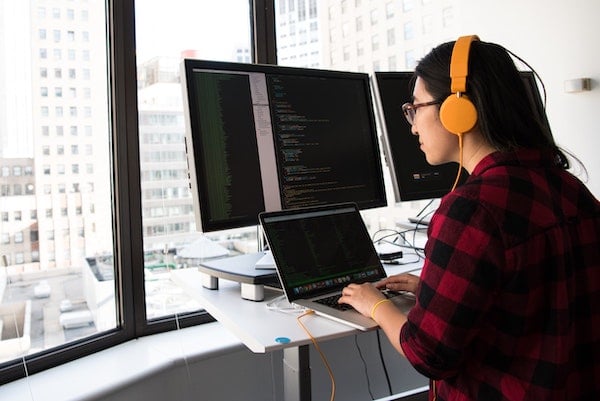Published on
Establishing a Strong Infrastructure for a Remote Shift

When social distancing was put in place in response to the COVID-19 pandemic, colleges and universities were concerned. The first thought most institutional leaders had was how to ensure learners received the best education they could from a distance and how to close out the semester in progress. But staff are also forced to adapt by running a tight ship in challenging circumstances. Providing an infrastructure that keeps staff and students both safe and secure is critical when working with private data and information. It’s also important to consider each other’s mental wellbeing during this time of isolation. In this interview, Heather McRae discusses what it takes to operationally shift to a remote environment, how to keep staff engaged and the innerworkings of keeping remote environments secure and accessible.
The EvoLLLution (Evo): What has it taken to transition institutional operations like into the online world?
Heather McRae (HMR): For years we’ve wanted to change our current practices in our front office through implementing technological solutions, but we were always met with some resistance from people who dislike change or didn’t see any need to change. Some thought it was a good idea, but without everybody’s buy-in, it was taking a long time for us to introduce new approaches–particularly in student service areas, where face-to-face communication was considered to be of primary importance.
When COVID-19 came, we were suddenly forced to change. In terms of business continuity, the approach we took was to mirror and identify core functions, such as advising and registration, to support the online delivery of programming continuity. When we were able to do that, it became fairly straightforward to adjust our practices, and we did that largely through teamwork.
Evo: What were some of the fundamental challenges that you had to overcome to create that really robust, highly flexible, operational environment at a time when people were getting used to a very different way of working?
HMR: With staff’s request to work from home because of COVID-19, we were able to move everything to a remote delivery format in four days. So that was all of our instruction, registration services including admissions, refunds, advising and course planning. Our staff had to work together to find solutions relating to the processing of forms and funding, as well as be able to support student inquiries and concerns.
Our early reports from staff working at home were quite positive and this encouraged others to move their operations home, too. Some moved within a day whereas others moved in four days. In the end, all staff were able to accomplish their tasks. Students were very positive and appreciative that they had an opportunity to talk with someone over the phone or via computer rather than having to communicate in person.
We organized our staff into work teams that met online twice daily to talk about their accomplishments, issues and to share their experiences. A number of staff demonstrated an amazing ability to troubleshoot and resolve problems for others. We encouraged everyone to keep as normal a schedule as possible, taking regular lunch hours and coffee breaks. Some units even set up a virtual coffee break, so that everybody could socialize as if they were working in the office.
To connect everyone within the school, as dean, I’ve been writing a daily email with updates and links to interesting sites. Our marketing team also organized a Keep Motivated with the School of Continuing Education Google site. Staff and faculty can add interesting links and nominate somebody each week whose exceptional contribution made a difference to others. It was through shifting this culture to online work but maintaining what we felt were extremely valuable relationships between staff members that was the real key to our success.
Evo: What does it take to ensure data security and compliance with the shift to sort of remote or online operations?
HMR: That was a concern that has always prevented us from considering allowing people to work from home. However, because of the pandemic, it was our IT staff that were instrumental in making online education possible. We worked with them to install a secure phone system on the registration staff’s laptops. We installed a VPN on all computers and provided access to all the applications needed to be successful at home, including Microsoft Teams, which is our primary meeting and chat tool(it’s worked extremely well for us).
Luckily our filing system was recently moved to an online platform by the university, so we are able to access information through the institution’s secured portal. All faculty and staff continue to use our student information system for both credit and non-credit studies. We’re working from home, but still following university requirements concerning the safety and security of information.
Evo: From an operational perspective, is it a tightly integrated system or is there a lot of manual data entry in order to create an automated looking environment?
HMR: When we first set up the school, instead of going with the cloud or a third-party registration system, we actually worked with our own IT department to set up a parallel structure within the university’s student record system. We now have two registration and student information systems for students: one is for undergraduate students and the other is for extension or non-credit students. It allows our functional analysts to work in both environments and develop both credit and non-credit courses within a single program. We definitely follow a lot of the protocols and procedures within the undergraduate registration processes. As a result, we were able to move online much easier because the systems were clearly in place, and we had the people to support any challenges we encountered.
Evo: Which elements of the online infrastructure do you think will stay in place once we move back to “normal”?
HMR: Our staff and faculty are already talking about the future. One key point is that we now know we can work remotely while maintaining our quality of service. We anticipate that staff will be working a few days each week from home or even more. But we’re going to continue to use this newly discovered technology in our everyday work no matter where staff are located. Meetings online are extremely efficient. We communicate more and better than ever. We’re investigating other types of technologies, such as Chatbox, to assist our work, but I have to say fear of technology is no longer an issue. I suspect our new professional world will be irrevocably changed. And that’s a good thing.
Evo: Is there anything you’d like to add about the shift to a remote operational infrastructure and what it takes to make these tools more broadly accessible and securely accessible to staff?
HMR: There are two parts to shifting to a remote world. One is to ensure that your technology is up to date and secure. We’ve all heard about the Zoom bombing and risks of external people accessing technology. That’s something we’re very cautious about. We don’t want students to feel that their information is not secure, so we’ve been doing our best to ensure we use encrypted lines. We follow all the IT safety protocols around using VPN, and we’re confident that we’ve been able to accomplish that.
The second part has to do with organizational culture. It’s important to support people working at home–particularly during a pandemic but also at any time. We’re ensuring that staff have opportunities to chat, hang out, but also to do collaborative work as a group because that’s such an important part of the work they do and so they never feel isolated. Initially our staff got together in the morning and again in the evening to let each other know how their day went before signing off. They now connect as a work team only once a day. I didn’t intend to continue writing daily emails to all faculty and staff, but I’ve received an incredible amount of feedback about it. Whether it’s a fun link or comic that I included or it’s just updating people of what’s going on in the university and what we’re working on, connecting with others has been critical
We’ve been able to transition from completing the winter term online, which was very sudden, to planning and getting prepared to offer our spring and summer terms entirely online. Even for courses we thought would be challenging to offer online because of practical components, our instructors have found alternatives that meet the required learning objectives.
Evo: From a customer’s perspective, how has the shift to a remote operational infrastructure going to support your capacity to meet the needs and expectations of your learners?
HMR: We’ve instilled in our instructors the importance of continuing to work within their teaching philosophy and provide a good environment to students. We tried to show through connecting remotely with our instructors and staff that “being human” through maintaining personal connections is really important. We’ve received a lot of positive comments from students who appreciate that they didn’t lose any progress in their academic year, that we continued to use grades rather than pass/fail. We felt we had collected enough assignments from students to be able to complete the year as normally as we could.
There are a number of international students whose worlds were shaken up because they couldn’t return home. Or if they do, they’re going to be in quarantine for a period of time and may not be able to get back to Canada. We’ve had to work with these vulnerable students and address their concerns, but to ensure that language learners felt that they were getting a valuable learning experience for.
This interview was edited for length and clarity.
Editor’s note: This interview was recorded on April 8, 2020.
Author Perspective: Administrator



